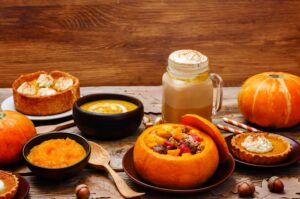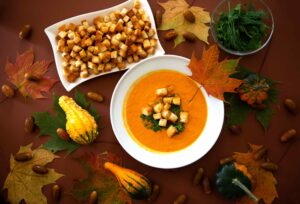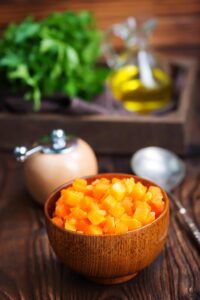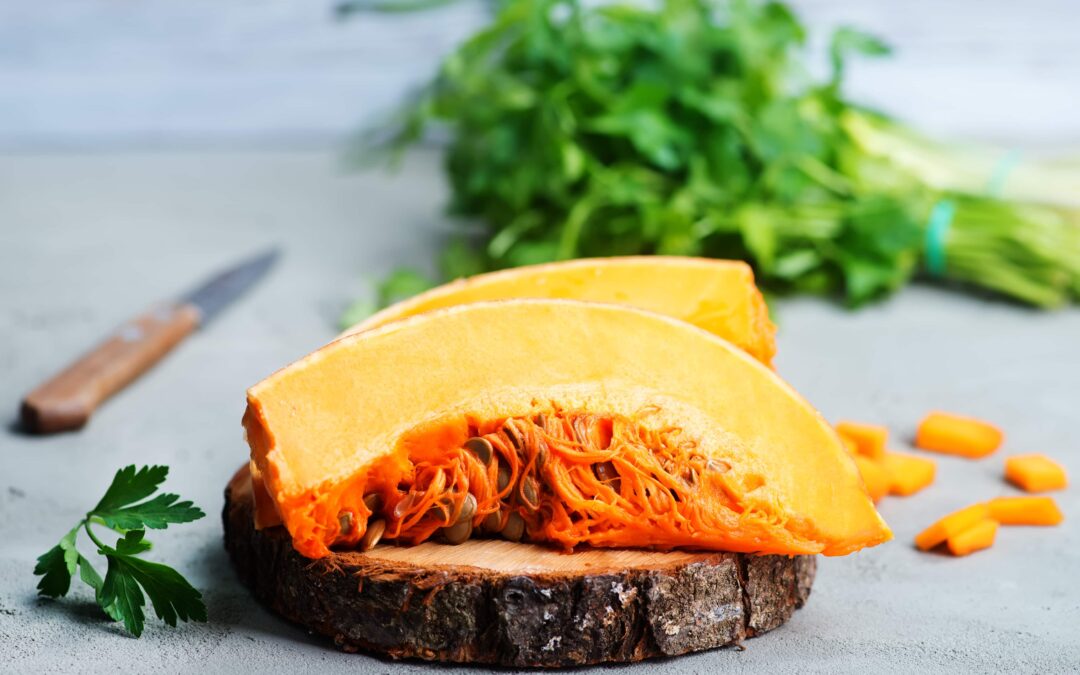The Pumpking of Fall Nutrition
It’s the autumn months, aka the season for pumpkins, so there’s no better time to look into why these fall-themed squashes are so healthy! While they’re great for carving, decorating, or even turning into a succulent pot, pumpkins hold a whole lot of nutritional value. From the seeds to the fleshy pulp, pumpkins have a lot of diversity in both their nutrition and inclusion in other recipes. We’ll go over the parts of the pumpkin, along with the different ways in which all of the pumpkin can provide nutrients.
Pumpkin Parts
Before we get into the nutritional benefits of pumpkins, we first should go over the anatomy of a pumpkin. A fresh pumpkin is made of multiple parts:
- Stem: This is the part of the pumpkin that’s attached to the pumpkin plant. It’s not very edible, though, and holds very little nutritional value. Best to not try and incorporate this into any recipes.
- Skin: Surrounding the pumpkin is the skin. While it’s a bit tougher than what’s below it, it’s still quite edible, and has its own nutritional benefits.
- Pulp: This is the layer just below the skin. It feels very similar to the inside of a cantaloupe or a melon, except for pumpkins, it’s a very light orange color.
- Seeds: The pumpkin seeds sit at the center of the pumpkin. They’re typically whiteish in color and surrounded by fibrous strands.
- Fibrous Strands: These are the structures that help hold the seeds in place. Each seed is connected to a fibrous strand. It acts as a sort of umbellic cord for the seed, providing it nutrients while it waits to be planted.
Now that we have all our parts, let’s look at the nutritional value of each part, as well as some ways to incorporate them into other recipes.
Skin

The pumpkin skin holds a lot nutrients in such a thin layer, especially in the vitamins department. They’re filled with vitamin A, vitamin B-6, vitamin C, vitamin E, potassium, iron, magnesium, and a few other nutrients in smaller quantities. In recipes, it can also provide a different texture that contrasts the pulp in a good way (think mashed potatoes with skin).
Many people turn the skin into a salted pumpkin chip that has less calories and more nutrients than your typical potato chip. As well, in a lot of recipes that use the pumpkin pulp, some cooks also put some pumpkin skin in the recipe. Blending the skin in with the pulp gives you the best of both worlds without the texture difference, if that’s not your thing.
Pulp
The pulp is the meaty part of the pumpkin, so it’s easy to incorporate into a multitude of recipes. And that’s great, because it’s so healthy! One cup of pumpkin is loaded with fiber, iron, potassium, zinc, vitamin A, vitamin C, antioxidants, and carotene alpha and beta. All this nutrition is packed into about 30ish calories of food. You can’t get a better deal than that!
Pumpkins have one of the, if not the greatest concentration of vitamin A. In one cup serving, it holds almost three times as much vitamin A than the average person needs in their daily diet
 Antioxidants are said to help with chronic inflammation and oxidative stress. Carotenes alpha and beta are products your body can use to produce its own vitamin A, which can help prevent age-related blindness and plays a role in keeping your immune system healthy. Especially now more than ever it’s important to keep your immune system happy and healthy. This, along with a strong combination of other vitamins, makes it a great food for almost everyone’s nutritional journey.
Antioxidants are said to help with chronic inflammation and oxidative stress. Carotenes alpha and beta are products your body can use to produce its own vitamin A, which can help prevent age-related blindness and plays a role in keeping your immune system healthy. Especially now more than ever it’s important to keep your immune system happy and healthy. This, along with a strong combination of other vitamins, makes it a great food for almost everyone’s nutritional journey.
One thing to watch out for is overeating pumpkin. While it takes a lot to reach that point, pumpkin does act as a mild diuretic, which can create problems with your health. As with any food, always eat it in moderation.
The pulp is pretty fleshy and can be eaten a lot of different ways. It can be eaten raw and cubed like a watermelon or cantaloupe. It can also be turned into a smoothie or a creamed soup. From hummus to adding steamed pumpkin pulp pieces to oatmeal to juicing it, there’s a lot of variety in the pumpkin pulp that a lot of people don’t take advantage of when they’re carving pumpkins. Hopefully we’ve given you ideas that’ll get the pulp past the scrap pile!
Seeds
The pumpkin seeds offer their own rich diversity of nutrients for us. In a one ounce serving, pumpkin seeds are loaded with proteins, vitamin K, magnesium, manganese, phosphorous, copper, zinc, and fats, six of which are omega fats.
Vitamin K is especially useful for good bone density. Magnesium is good to improve metabolism and exercise performance, as well as helping fight depression. Manganese is a part of one of the most important antioxidants in your body, which helps with disease prevention and eliminating free radicals. Each of the vitamins plays a different role in keeping you healthy, and with so many present in pumpkin seeds, you’ll be set!
While you can eat the pumpkin seeds raw, they have much more flavor when they’ve been roasted, where their flavor really shines. Add a bit of oil and some of your favorite spices and you’ll have a great and healthy snack to take wherever you go!
Fibrous Strands
While you can technically eat the fibrous strands, they have both a rough flavor and texture that tends to not be enjoyed by many. The fibrous strands tend to do much better being used as an additive for creating a vegetable broth. Just remove the fibrous strands from the rest of the pumpkin, sauté the pulp with diced onions and other vegetable scraps you have lying around, then add water and let the veggie mix simmer for 30 to 60 minutes before straining the scraps out. Incorporating the fibrous strands into a vegetable broth will provide some of the vitamin and mineral benefits of the pumpkin pulp in your own homemade broth.
Takeaway

Pumpkins hold a lot of diverse nutritional benefits. From the skin to the seeds, a pumpkin has a lot of ways to pick up the health benefits of pumpkin. They also can be incorporated into a whole bunch of different recipes. One pumpkin can go a long way for your nutritional journey, and turning that “wasted scrap” we produce after carving pumpkins into a healthy meal or snack is a good way to reduce your waste. We’d love to hear the ways you’ve turned your pumpkin into a tasty treat!

